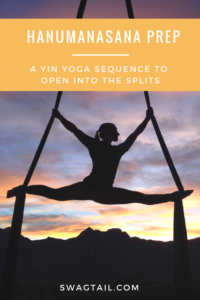 Hanumanasana, or the yoga splits, is a challenging posture where both legs are doing opposite actions. I recall learning basic gymnastics at the ripe, young age of 5. This led to baton-twirling, and within a year, I was cut from the squad. More dance maneuvers were required, and my inability to do the splits left me far behind the crowd. Over the years, I pursued other athletic endeavors that did not require much flexibility. However, starting yoga over 15 years ago changed that. Now, I’m back on a constant path to increase muscular strength and elasticity. Instead of quitting, this time, I’m committed to this practice for life. This includes a more regular inclusion of challenging poses into my weekly sequences. When doing the splits in a more passive practice, such as yin yoga, more focused attention must be applied to remain safe. The yin yoga sequence for the splits is outlined below to do just that!
Hanumanasana, or the yoga splits, is a challenging posture where both legs are doing opposite actions. I recall learning basic gymnastics at the ripe, young age of 5. This led to baton-twirling, and within a year, I was cut from the squad. More dance maneuvers were required, and my inability to do the splits left me far behind the crowd. Over the years, I pursued other athletic endeavors that did not require much flexibility. However, starting yoga over 15 years ago changed that. Now, I’m back on a constant path to increase muscular strength and elasticity. Instead of quitting, this time, I’m committed to this practice for life. This includes a more regular inclusion of challenging poses into my weekly sequences. When doing the splits in a more passive practice, such as yin yoga, more focused attention must be applied to remain safe. The yin yoga sequence for the splits is outlined below to do just that!
SEQUENCE OVERVIEW
This hanumanasana-focused yin yoga sequence is outlined in a 60-minute format. Remind your students that yin yoga only requires 50-70% of their maximum stretch, as these postures will be held for longer than they would in an active class. It’s especially true to start on the easier end of the spectrum when focusing on the splits, where the mobility in one leg could potentially limit the action of the other. Just as in life, patience is essential. Tell your students this again and again!
Props suggested: 2 Blocks and a strap (a bolster and blankets are optional)
Contraindications: If any student has groin or hip injuries, they may want
to postpone completing this sequence.
BEGIN THE YIN SEQUENCE IN DANGLING POSE
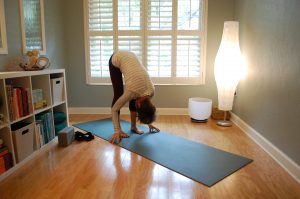 Length: Hold for 2 minutes
Length: Hold for 2 minutes
Purpose: The goal of starting in dangling pose, also known as utanasana, is to lengthen the entire back line of the body, as well as provide a slightly inverted posture that can calm the mind. The benefit is that there is still some balance needed to prevent falling over. This provides a nice way to transition from whatever occurred just for your students (most likely a busy or active endeavor) into the still-based nature of the yin yoga practice.
Additional Support:
- Close the eyes and focus the attention inward.
- Bend the knees generously to release the low back.
- Rest your elbows on the thighs for additional support.
Suggested Pranayama: Cultivate internal awareness by allowing the breath to be natural, and if possible, have your students send their attention to the back line of the body. Have them notice any areas that are holding tension, and send the breath specifically there.
To transition into the next posture, inhale to lengthen the spine and then step the left foot back.
POSTURE 1: DRAGON, WITH RIGHT FOOT FORWARD
Length: Hold for 5 minutes
Purpose: Dragon, also known as low lunge or anjaneyasana, is a deep hip stretch that addresses the hip flexors and quadriceps of the back leg immediately. It is also a great way to focus on keeping the back leg internally rotated. This muscle memory is essential when entering hanumanasana, and building that memory now is helpful.
Additional Support:
- Place a blanket under the back knee for support.
- Use the breathe to lengthen the whole front line of the body.
- Keep the arms as straight as possible to minimize upper body strength to
- hold the torso up.
- Place blocks under the hands if the floor is inaccessible.
- Make fists with the hands if the wrists get tired supporting the upper
- body.
Suggested Pranayama: Focus on an even breath. Count how long it takes to complete the inhale, and then have students try to make the length of the exhale that same count. This will start to bring a sense of evenness to the mind. This will also help prepare the body for the balance that is necessary for the splits.
To transition out of the pose, step the back foot forward to come in to dangling pose, or uttanasana, again.
POSTURE 2: DANGLING, ROUND 2
 Length: 2 minutes
Length: 2 minutes
Purpose: Dangling pose is a symmetrical posture that can bring the body back to balance between sides. There will be a noticeable difference in the legs as a result of the previous time in dragon. Allow the mind to become aware of those sensations. Focus on any openness in the body, and observe how they might be memorized for future practice of hanumansana.
To transition to posture 3, step the right foot back into dragon.
POSTURE 3: DRAGON, LEFT FOOT FORWARD
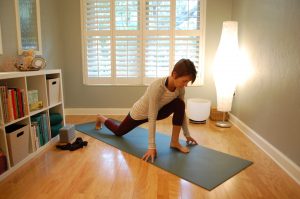 Length: Hold for 5 minutes
Length: Hold for 5 minutes
Purpose: It’s time to lengthen the hip flexors and quadriceps on the right side now. The same options apply for additional support, and an even-count pranayama will be helpful here to facilitate equanimity in the mind and body.
To transition, have your students come to a seat.
POSTURE 4: CATERPILLAR
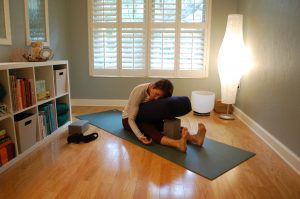 Length: Hold for 3 minutes
Length: Hold for 3 minutes
Purpose: Caterpillar is the seated version of dangling pose. In an active practice, it’s known as paschimottanasana, or seated forward bend. Because hanumanasana is an asymmetrical posture, it’s refreshing to prepare for this pose in a more even fashion to lengthen the hamstrings. And, we all know, the splits require lots of hamstring flexibility.
Additional Support:
- Sit on a blanket, and keep the hips rotating forward.
- Bend the knees as much as needed (or place rolled blanket under the back
- of the knees) to offset tight hamstrings or low back regions.
- Place blankets or a bolster under your torso for additional support and
- relaxation.
- Support the head with some sort of prop to remove any strain in the neck.
Suggested Pranayama: Counting the length of the breath in and out has already taken place during the two rounds in dragon. This time, make the
exhale longer than the inhale. If students inhaled to a count of four, have them exhale to a count of 6. If they inhaled to a count of 5, try to exhale to a count of 8. The goal here is to cultivate a deeper sense of relaxation that will be needed when more challenging poses arrive.
Counter pose: Shake out the legs, or move them in a windshield wiper fashion.
POSTURE 5: SUPTA PADANGUSTASANA, RIGHT LEG
Length: Hold for 5 minutes
Purpose: The hamstrings and hip flexor muscles have received attention in the previous poses, although separately. Supta Padangustasana takes the opposite actions in both legs and addresses them in this singular posture.
Additional Support:
- Wrap the strap around the wrists to minimize grip fatigue
- Form a loop with the strap, and place the loop behind the head (if
- students are more flexible)
- Place a micro-bend behind the right leg, to soften the hamstring stretch
- Bend the left leg, and place the foot on the floor (If students less
- flexible)
- Keep the upper body as relaxed as possible.
Suggested Pranayama: Take a few rounds of brahmari pranayama, or what is also known as bee breath, when comfortable in this pose. The buzzing sound will not only create a focal point for the mind, but the vibrations generated can increase relaxation in the body. Repeating a few rounds of buzzing can also be done around minute 3 to re-focus the mind.
POSTURE 6: SAVASANA
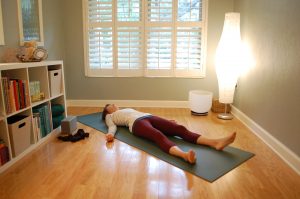 Length: 1 minute
Length: 1 minute
Purpose: Corpose pose is the neutralizing counter pose for the body. Allow the low back to hang softly. Notice the back of the pelvis evenly grounded on the mat. Allow the body to breath itself naturally, as the mind observes any sensations that have resulted from the previous posture.
POSTURE 7: SUPTA PADANGUSTASANA, LEFT LEG
Length: Hold for 5 minutes
Purpose: The goal is to find overall balance in the body. Taking thi pose on the second side allows the hamstrings on the left leg to extend, and the hip flexors on the right to lengthen. The same options for additional support apply, and another few rounds of brahmari pranayama can be utilized before settling into the stillness of the pose. Repeating a few rounds of buzzing can also be done around minute 3 to re-focus the mind.
POSTURE 8: SAVASANA, REPEATED
Take savasana here for a minute or two to neutralize the spine, hips, and legs. Allow the breath to be effortless, and turn the attention of the mind to any new sensations that resulted from the deep hamstring work thus far. Also, focus on a sense of softness in the legs, as it’s important to ease your way into the splits without force.
POSTURE 9: SPHINX POSE
Length: Hold for 2 minutes
Purpose: The goal here is to lengthen the front of the body in a symmetrical fashion. This also helps train the heart to stay open to possibility, especially considering the challenge of hanumansana ahead.
Additional Support:
- Create a loop in the strap, and place it around the upper arm bones. This can help keep them shoulder’s distance apart.
- Move the elbows slightly forward of the shoulder to reduce low back compression
- Place a blanket under the elbows to prevent soreness
- Place a bolster under the armpits to relax arms completely.
Suggested Pranayama: Simple ujjayi breath is great here.
POSTURE 10: CHILD’S POSE
Length: 1 minute
Purpose: Rounding the spine in this symmetrical posture is a perfect counter pose to the backbend of sphinx. It’s also a neutral pose that helps prepare for the upcoming splits.
Suggested Pranayama: Release all breath control.
POSTURE 11: DRAGON VARIATION, SPLITS, RIGHT FOOT FORWARD
Length: Hold for 5 minutes.
Purpose: The best way to build flexibility in hanumanasana, or dragon splits, is to take the posture itself, and doing so mindfully is essential. Yin yoga can seem like a more passive form of the physical practice. Repeating this posture helps create a mental imprint in the cells of the body to safely increase length of the front leg extensor muscles and back leg flexion ones. One way to do this is focus on an internal rotation of both legs, as this helps keep them in the neutral position (essential for long term safety and sustainability).
Additional Support:
- Start in ardha hanumanasana (or half splits), keeping hips over back knee, for the easiest variation.
- Place blocks under the hands, or under the front extended leg, for more support.
- Make sure to start on the spectrum of easy when entering this pose. As time progresses, the body can relax and more freedom will be found. Just be patient with yourself, and your body.
Suggested Pranayama: Identify the four parts of the breath–(1) puraka or inhalation, (2) rechakaor exhalation, and (3) kumbaka or pausing of breath, which occurs at the top and bottom of the breath.
I suggest practicing this four-part breath in equal ratios during this pose. Inhale to a count of 4, hold the breath in to a count of four, exhale to a count of four, and hold the breath out for four seconds. The body will want to retain tension during the kumbaka segments. Remind students to relax, with ease, while pausing of the breath occurs. This will serve as a reminder to keep the body soft in this posture.
POSTURE 12: DOWNWARD FACING DOG / PLANK
Length: Move for 2 minutes.
Purpose: Movement can offset any unintended tension from dragon splits. Down Dog is a fantastic way to lengthen the entire back body again in an even way. This also invites the arms to participate in the yoga sequence. Inhaling into plank pose will tap into the strength necessary to commit to this practice of hanumanasana. Continue moving on the exhale into down dog, an use the inhale back to plank. Complete for one minute, before taking child’s pose again (if desired). The movement of cat/cow can also be a wonderful, low key alternative here.
Additional Support:
- Keep the knees bent to lengthen the spine.
- Ground down through the base of each finger.
- Support the head with a block, on any level, if your mind is getting in the way of experiencing the pose.
Suggested Pranayama: Ujjayi pranayama is a nice accompaniment to this moving sequence.
POSTURE 13: DRAGON VARIATION, LEFT LEG FORWARD
Length: Hold for 5 minutes.
Purpose: Taking the second side here will create whole body balance.
The same additional support options apply here, and the four-part breath can be utilized again. It’s important to note that this side of the posture will most likely be very different from the first. Respect your body. Accept those differences. Love the process of the postures to get more deeply into the core of your being.
END THE YIN SEQUENCE IN SAVASANA
It’s great to end this yin yoga sequence in savasana. Let go of any breath control, and allow the body to absorb all of the changes made during the practice. Hanumanasa is a posture that requires focus, dedication, and patience. Encourage the mind to focus on these attributes. Notice how they can infuse the body even in a completely still position, and begin to imagine how they can manifest in the splits as well as other postures taken in life


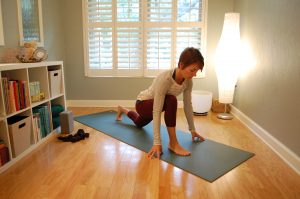
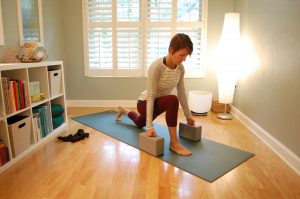
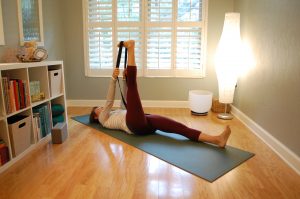
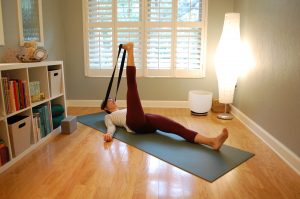
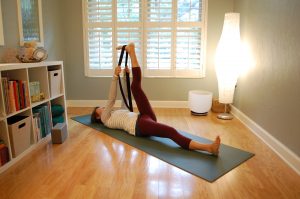
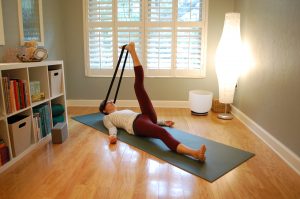
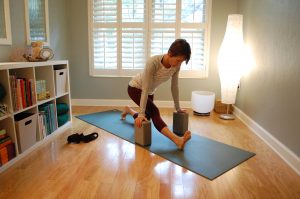
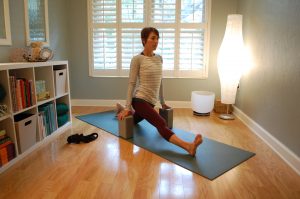
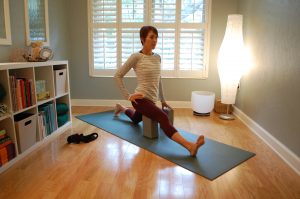
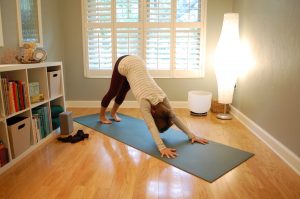
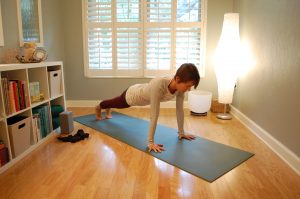
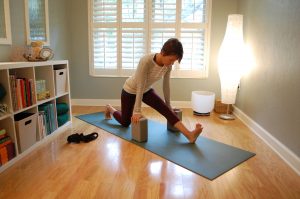
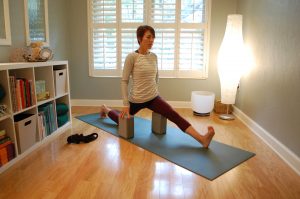
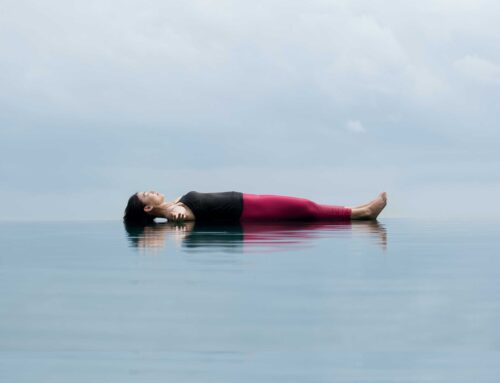

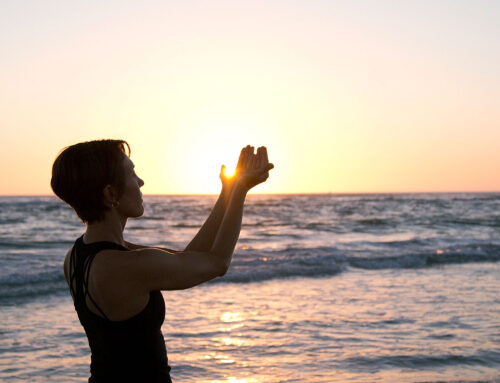
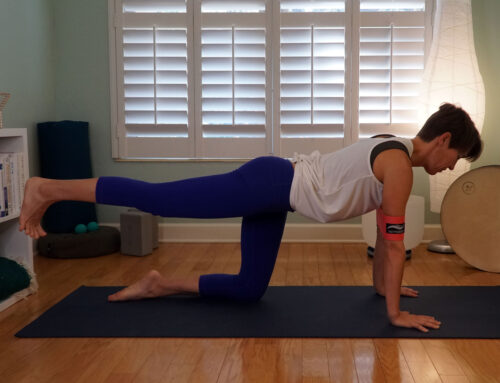
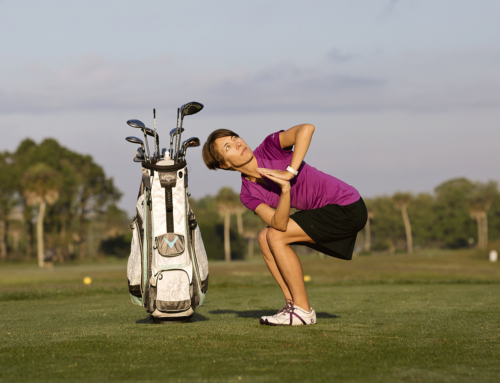
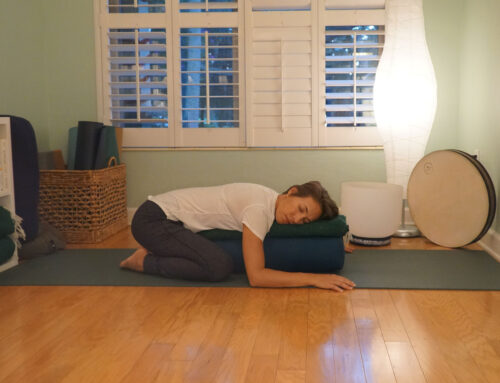

Leave A Comment